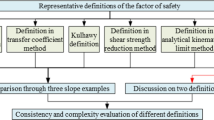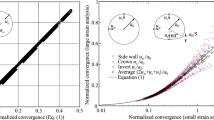Abstract
The simplified methods based on the cone penetration test (CPT), standard penetration test (SPT), and shear wave velocity (V s ) test are prevalent in liquefaction potential evaluation. In this study, new case histories with the shear wave velocity measurements and the liquefaction phenomenon observations are compiled from the 22 February 2011 Canterbury earthquakes in New Zealand. The new case histories are combined with the existing V s database for assessing and updating probabilistic models. The widely used logistic regression models, as well as other probabilistic models, are examined in the framework of generalized linear models (GLMs). To this end, the maximum likelihood estimation (MLE) principle is used to determine the model parameters. Then, the developed generalized linear models are ranked using three model assessment criteria. Based on the assessment criteria adopted, the log–log and logistic models are recommended for both the existing and the combined database. The updated log–log model and logistic model are recommended for shear wave velocity based liquefaction potential evaluation.








Similar content being viewed by others
References
Akaike H (1973) Information theory and an extension of the maximum likelihood principle. In: Petrox BN, Caski F. (eds) Second International Symposium on Information Theory (pp 267–281). Akademia Kiado, Budapest
Andrus RD, Stokoe KH II (2000) Liquefaction resistance of soils from shear-wave velocity. J Geotech Geoenviron Eng 126(11):1015–1025
Andrus RD, Stokoe KH, Chung RM (1999) Draft guidelines for evaluating liquefaction resistance using shear wave velocity measurements and simplified procedures. US Department of Commerce, Technology Administration, National Institute of Standards and Technology
Andrus RD, Stokoe KH, Juang CH (2004) Guide for shear-wave-based liquefaction potential evaluation. Earthquake Spectra 20(2):285–308
Boulanger RW, Idriss IM (2012) Probabilistic standard penetration test-based liquefaction–triggering procedure. J Geotech Geoenviron Eng 138(10):1185–1195
Bradley BA, Hughes M (2012) Conditional peak ground accelerations in the Canterbury earthquakes for conventional liquefaction assessment. In Technical Report for the Ministry of Business, Innovation and Employment, New Zealand
Cetin KO, Der Kiureghian A, Seed RB (2002) Probabilistic models for the initiation of seismic soil liquefaction. Struct Saf 24(1):67–82
Cetin KO, Seed RB, Der Kiureghian A, Tokimatsu K, Harder LF Jr, Kayen RE, Moss RE (2004) Standard penetration test-based probabilistic and deterministic assessment of seismic soil liquefaction potential. J Geotech Geoenviron Eng 130(12):1314–1340
Chen CJ, Juang CH (2000) Calibration of SPT-and CPT-based liquefaction evaluation methods. Geotechnical Special Publication, pp 49–64
Christian JT, Swiger WF (1975) Statistics of liquefaction and SPT results. J Geotech Eng Div 101(11):1135–1150
Cubrinovski M, Bradley B, Wotherspoon L, Green R, Bray J, Wood C, Wells D (2011) Geotechnical aspects of the 22 February 2011 Christchurch earthquake. Bull NZ Soc Earthquake Eng 44(4):205–226
Fox J (2015) Applied regression analysis and generalized linear models. 3rd edn. Sage Publications
Gelman A, Carlin JB, Stern HS, Rubin DB (1995) Bayesian data analysis (vol 2). Chapman & Hall/CRC
Gessler PE, Moore ID, McKenzie NJ, Ryan PJ (1995) Soil-landscape modelling and spatial prediction of soil attributes. Int J Geograph Info Syst 9(4):421–432
Gotway CA, Stroup WW (1997) A generalized linear model approach to spatial data analysis and prediction. J Agric Bio Environ Stat 2(2):157–178
Green RA, Cubrinovski M, Cox B, Wood C, Wotherspoon L, Bradley B, Maurer B (2014) Select liquefaction case histories from the 2010–2011 Canterbury earthquake sequence. Earthquake Spectra 30(1):131–153
Juang CH, Chen CJ, Jiang T (2001) Probabilistic framework for liquefaction potential by shear wave velocity. J Geotech Geoenviron Eng 127(8):670–678
Juang CH, Jiang T, Andrus RD (2002) Assessing probability-based methods for liquefaction potential evaluation. J Geotech Geoenviron Eng 128(7):580–589
Juang CH, Fang SY, Tang WH, Khor EH, Kung GTC, Zhang J (2009) Evaluating model uncertainty of an SPT-based simplified method for reliability analysis for probability of liquefaction. Soils Found 49(1):135–152
Juang CH, Ching J, Luo Z, Ku CS (2012) New models for probability of liquefaction using standard penetration tests based on an updated database of case histories. Eng Geol 133:85–93
Khoshnevisan S, Juang CH, Zhou YG, Gong W (2015) Probabilistic assessment of liquefaction-induced lateral spreads using CPT—focusing on the 2010–2011 Canterbury earthquake sequence. Eng Geol 192:113–128
Ku CS, Juang CH, Chang CW, Ching J (2012) Probabilistic version of the Robertson and Wride method for liquefaction evaluation: development and application. Can Geotech J 49(1):27–44
Lane PW (2002) Generalized linear models in soil science. Eur J Soil Sci 53(2):241–251
Liao SS, Veneziano D, Whitman RV (1988) Regression models for evaluating liquefaction probability. J Geotech Eng 114(4):389–411
McKenzie NJ, Ryan PJ (1999) Spatial prediction of soil properties using environmental correlation. Geoderma 89(1):67–94
Myung JI, Pitt MA (2004) Model comparison methods. Methods Enzymol 383:351–366
Orense RP, Kiyota T, Yamada S, Cubrinovski M, Hosono Y, Okamura M, Yasuda S (2011) Comparison of liquefaction features observed during the 2010 and 2011 Canterbury earthquakes. Seismol Res Lett 82(6):905–918
Robertson PK, Wride CE (1998) Evaluating cyclic liquefaction potential using the cone penetration test. Can Geotech J 35(3):442–459
Schwarz G (1978) Estimating the dimension of a model. Ann Stat 6(2):461–464
Seed HB, Idriss IM (1971) Simplified procedure for evaluating soil liquefaction potential. Journal of Soil Mechanics & Foundations Div
Stone M (1974) Cross-validatory choice and assessment of statistical predictions. Journal of the Royal Statistical Society. Series B (Methodological), 111–147
Tonkin and Taylor (2013) Liquefaction vulnerability study, Tonkin and Taylor Report 52020.0200/v1.0. February 2013
Toprak S, Holzer TL, Bennett MJ, Tinsley JC (1999) CPT-and SPT-based probabilistic assessment of liquefaction potential. In: Proc., 7th US–Japan Workshop on Earthquake Resistant Design of Lifeline Facilities and Countermeasures against Liquefaction
Youd TL, Idriss IM, Andrus RD, Arango I, Castro G, Christian JT, Dobry R, Finn WL, Harder LF Jr, Hynes ME, Ishihara K, Koester JP, Liao SSC, Marcuson WF, Martin GR, Mitchell JK, Moriwaki Y, Power MS, Robertson PK, Seed RB, Stokoe KH (2001) Liquefaction resistance of soils: summary report from the 1996 NCEER and 1998 NCEER/NSF workshops on evaluation of liquefaction resistance of soils. J Geotech Geoenviron Eng 127(10):817–833
Zhang J, Zhang LM, Huang HW (2013) Evaluation of generalized linear models for soil liquefaction probability prediction. Environ Earth Sci 68(7):1925–1933
Zhou YG, Liang T, Ling DS, Chen YM (2012). Liquefaction performance case histories in Christchurch area during the 2010 and 2011 earthquakes from cone penetration test and shear wave velocity. Proceedings, Second International Conference on Performance-based Design in Earthquake Geotechnical Engineering. May 28–30, 2012, Taormina, Italy
Author information
Authors and Affiliations
Corresponding author
Appendix: Summary of the Andrus and Stokoe (2000) method
Appendix: Summary of the Andrus and Stokoe (2000) method
Factor of safety F s is computed as:
Cyclic stress ratio CSR 7.5 is computed as:
where τ av is the average equivalent uniform cyclic shear stress caused by the earthquake and assumed to be 0.65 of the maximum induced stress; a max is the peak horizontal ground surface acceleration; g is the acceleration of gravity; σ v is the total overburden stress in kPa; σ′ v is the initial effective overburden stress in kPa, and γ d is a shear stress-reduction coefficient given as
where z is the depth below the ground surface.
MSF is the magnitude scaling factor, defined as:
Cyclic resistance ratio CRR7.5 is computed as:
where V s1,cs is the clean sand equivalence of stress-corrected shear wave velocity designated as modified shear wave velocity here.
where
K fc is a fines content correction to adjust values to a clean soil equivalent.
V s1 is the stress-corrected shear wave velocity
C vs is a factor to correct measured V s for overburden pressure.
P a is a reference stress of 100 kPa.
Rights and permissions
About this article
Cite this article
Shen, M., Chen, Q., Zhang, J. et al. Predicting liquefaction probability based on shear wave velocity: an update. Bull Eng Geol Environ 75, 1199–1214 (2016). https://doi.org/10.1007/s10064-016-0880-8
Received:
Accepted:
Published:
Issue Date:
DOI: https://doi.org/10.1007/s10064-016-0880-8




